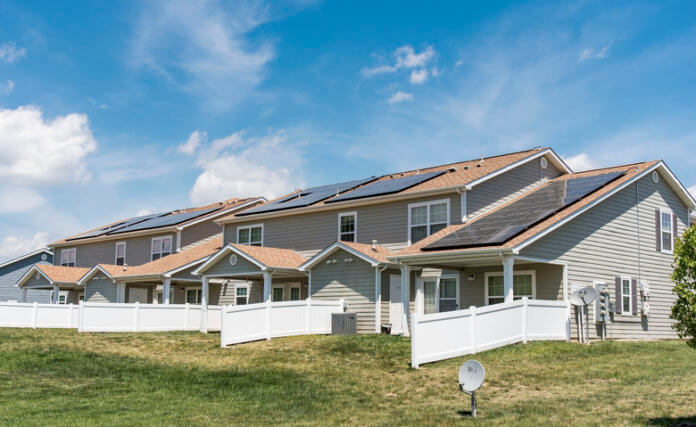The growth of rooftop solar in the U.S. has been supported substantially by state net metering programs. The Energy Policy Act of 2005 mandated that each utility make available, upon request, net metering service to any electric consumer that the electric utility serves.
“Net metering service” is broadly defined under the federal statute to cover electric energy generated by that electric consumer from an eligible on-site generating facility and delivered to the local distribution facilities that may be used to offset electric energy provided by the electric utility to the electric consumer during the applicable billing period. The federal government has taken a hands-off approach to the implementation of net metering programs, leaving states as the driver.
As retail solar adoption has grown, some states have taken steps to encourage the growth of rooftop solar, while other states have rolled back some of the benefits of net metering benefits. This overview reviews two states (one contracting, one expanding) that made net metering changes in 2019, and provides context for new challenges in a state with an existing robust framework.
Michigan (Contracting)
In 2016, the Michigan legislature passed a law (Public Acts 341 and 342) mandating that the Michigan Public Service Commission (MPSC) phase out the state’s net metering program (which provides compensation for excess generation at the full retail rate) and create a new distributed generation program.
Pursuant to this legislation, in April 2018 (MPSC Case No. U-18383), the MPSC adopted a distributed generation program with a compensation rate based on an “inflow/outflow billing mechanism.” Under an inflow/outflow billing mechanism, the customer pays one price for the energy it purchases from the utility (the inflow) and receives another price for the excess energy the customer’s generator sends to the grid (the outflow).
The MPSC is also in an ongoing stakeholder process to updates its electric interconnection and net metering standards, with a target to implement new rules in 2020.
In July 2018 (MPSC Case No. U-20162), DTE Electric Co. proposed an inflow/outflow billing mechanism pursuant to which energy the customer uses from the grid would continue to be billed at the customer’s full retail rate, but the excess energy the customer’s generator sends to the grid would only be credited to the customer at DTE’s average monthly wholesale price of energy (a rate significantly lower than DTE’s full retail rate).
In its May 2019 ruling, the MPSC ordered that DTE revise the outflow credit to be based on the power supply component of the customer’s retail rate (minus transmission charges). This revised outflow credit results in a higher credit than proposed by DTE, but lower than the full retail rate credit received under the net metering program.
The MPSC also rejected a proposal by DTE to impose a system-access contribution charge on distributed generation customers based on the size of their energy system. These requirements apply to new distributed-generation customers, while existing customers can continue under their current program for 10 years from enrollment.
In addition, Michigan continues to cap participation in distributed-generation programs at 1% of the electric utility’s average in-state peak load for the preceding five years.
Washington (Expanding)
In contrast, Washington state, as part of a package of clean energy legislation passed in 2019, raised each electric utility’s net metering threshold to 4% (from the previous threshold of 0.5%). Thus, Washington electric utilities will make net metering available to eligible customer-generators on a first-come, first-served basis until the earlier of the first date upon which the cumulative generating capacity of net metering systems equals 4% of the utility’s peak demand during 1996, or June 30, 2029.
Washington values net metering credits at the customer’s full retail rate. In addition, beginning in July 2019, Washington also implemented a sales tax exemption for solar energy systems under 100 kW through 2029.
California (Stasis)
California saw big changes to net energy metering in the last several years, with the implementation of NEM 2.0 (2016), a rooftop solar mandate on new construction (2018), and an overall increasing growth in the amount of behind-the-meter solar.
As a result, California is now dealing with the issues resulting from this massive expansion. For example, this year it began to tackle issues related to credit and expense policy implementation through NEM 2.0 and related programs, such as the Solar on Multifamily Affordable Housing program.
Most publicly, however, the California Public Utilities Commission has focused on enhanced consumer protections for net energy metering customers. This includes both standardizing materials for cost-saving estimates provided to potential customers and new educational materials on the financial commitment of rooftop solar, as well as new documents for solar providers required prior to interconnecting a residential solar customer in the territories of the main investor-owned utilities in the state.
Additionally, as increasingly devastating and deadly wildfires continued to threaten California this year and utilities reacted with disruptive public safety power shutoff events, the state has seen a renewed interest in distributed generation not just for the value proposition, but for safety and reliability reasons.
In the future, as more behind-the-meter solar comes online and reduces the value of the system (by limiting the amount of exports such a system can send to the grid), California will likely have to deal with increasingly hybrid systems that include storage in addition to solar.
Without any national net metering policy, states will continue to diverge in their implementation. So, stay tuned for more state net metering developments in 2020.
Jennifer Mersing is of counsel at Stoel Rives LLP, where her practice focuses on electric regulatory issues, including Federal Energy Regulatory Commission and certain state public utility commission matters. Sarah Kozal is an associate in Stoel Rives’ energy development group, where her practice focuses on the California energy market and other state regulatory issues.




